The Essential Guide to Rockhound Hammers in Collecting


Intro
Rock collecting, or rockhounding, has captivated many enthusiasts, whether they are seasoned geologists or curious beginners. One of the most crucial tools employed in this pursuit is the rockhound hammer. This simple yet effective tool is pivotal for anyone looking to delve deeper into the intricate world of geology and fossil collecting. Understanding its significance, the varieties available, and their specific uses is not just useful but essential for a successful collecting experience.
In this guide, we’ll traverse various aspects related to rockhound hammers, dissecting different types and their applications, as well as keeping safety considerations front and center. We’ll also touch on the techniques that can elevate a collector’s skills and enhance the longevity of these indispensable tools.
So, let’s break ground and explore how rockhound hammers serve as the backbone for anyone with a passion for rocks and fossils.
Featured Collectible of the Month
Overview
This month, the spotlight shines on ammonite fossils. These stunning fossils are not just visually striking with their coiled shell structure and intricate patterns; they hold centuries’ worth of geological history within their spirals. The interest in collectin’ ammonite fossils has surged due to their beauty and importance in understanding ancient marine ecosystems. A rockhound hammer plays a vital role in extracting these delicate specimens from their rocky encasements, ensuring they remain intact for display or study.
Historical Significance
Ammonites flourished during the Mesozoic Era and became extinct around 65 million years ago, which makes them an integral part of the earth’s paleoecological narrative. The process of excavatin’ these fossils not only connects collectors to the past but sheds light on the evolutionary processes that shaped marine life. With the right hammer, collectors can carefully tap into rock layers where these fascinating specimens are often hidden away, unveil their ancient secrets, and contribute to the ongoing story of our planet.
Identification Techniques
Visual Characteristics
When out huntin’ for ammonite fossils, it’s vital to know what you’re looking for. Here are some visual characteristics to keep in mind:
- Spiral Shape: Ammonites typically have a coiled shell structure.
- Suture Patterns: Look for intricate lines on the shell surface that indicate chambers within the fossil.
- Color Variations: Often, ammonites can present in hues of brown, black, and sometimes even iridescent finishes when polished.
Resources for Identification
Identifying ammonites can be made easier with a handful of resources:
- Books: "Fossils of the World" offers an extensive guide to recognizing various fossils, including ammonites.
- Online Forums: Visiting platforms like reddit.com can be a treasure trove of community knowledge where enthusiasts share tips and experiences in fossil hunting. Make sure to check relevant threads!
- Museums: Universities often host geological displays where experts can help confirm identifications and offer insights.
To wrap it up, rockhound hammers are not just tools; they’re companions in a journey through time. Collectors, be it hobbyist or professional, must recognize the essential role these hammers play in both collecting and preserving the beauty of natural history.
Prelims to Rockhound Hammers
Rockhound hammers are indispensable tools for anyone looking to delve into the fascinating world of geology and fossil collecting. These hammers are not just for breaking rocks; they serve multiple purposes, depending on their design and intended use. Understanding their role offers practical benefits for both novices and seasoned collectors. This article aims to shed light on the significance of rockhound hammers, ensuring that you’re well-equipped for your geological expeditions.
Defining Rockhound Hammers
Rockhound hammers, often referred to as geological hammers, are specially designed tools used primarily for rock collecting and geological exploration. They typically feature a heavy metal head and a sturdy handle, allowing for effective striking against various rock types. Unlike standard hammers, these are crafted with precision: one side is often pointed for breaking rocks, while the other is flat for chipping away at layers or splitting surfaces.
When defining rockhound hammers, it’s important to consider the varying types that cater to different collecting needs. For instance, the pointed hammer is ideal for making clean breaks and uncovering fossils without much damage to them. Conversely, flat hammers excel in chiseling or prying, making them practical for those who seek crystals or well-preserved specimens. The choice of hammer can dramatically influence both the effectiveness of your collecting and the condition of your finds.
Historical Context of Geological Tools
The story of rockhound hammers traces back centuries into our relationship with the Earth. Early humans used rudimentary stone tools for navigating and utilizing their environment, marking the beginning of tool-making for geological purposes. Over time, as our understanding of geology evolved, so did the tools we used.
By the 19th century, with the rise of professional geology, tools like the rock hammer became more refined. Collectors and geologists began to recognize the importance of having the right instrument, leading to the development of specialized hammers to suit various needs. As you hold a rockhound hammer in your hand, you’re gripping a piece of history—an evolution from crude implements to finely crafted instruments that augment our exploration of Earth’s treasures.
"The right tool can make a world of difference in the field; it doesn’t just enhance your efficiency but also respects the integrity of what you’re collecting."
This historical backdrop is crucial for appreciating these tools in the present day. Understanding the advancements and the reasons behind certain designs can inform your choices, allowing for more strategic and responsible collecting practices. As you venture into the field, the legacy of these hammers should resonate, underpinning their significance in connecting with and understanding our planet.
Types of Rockhound Hammers
Understanding the types of rockhound hammers is crucial for anyone passionate about collecting geological specimens. Each type of hammer comes with unique design features and serves specific purposes, greatly influencing the efficiency and safety of rock collecting. Choosing the right hammer not only affects what and how you collect, but also impacts your efforts to study and preserve the geological wonders you encounter in your adventures. Having the right tool can make all the difference; it's akin to a painter choosing the brush that best suits their style.
Pointed Hammers
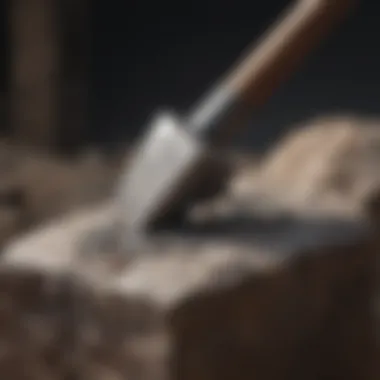
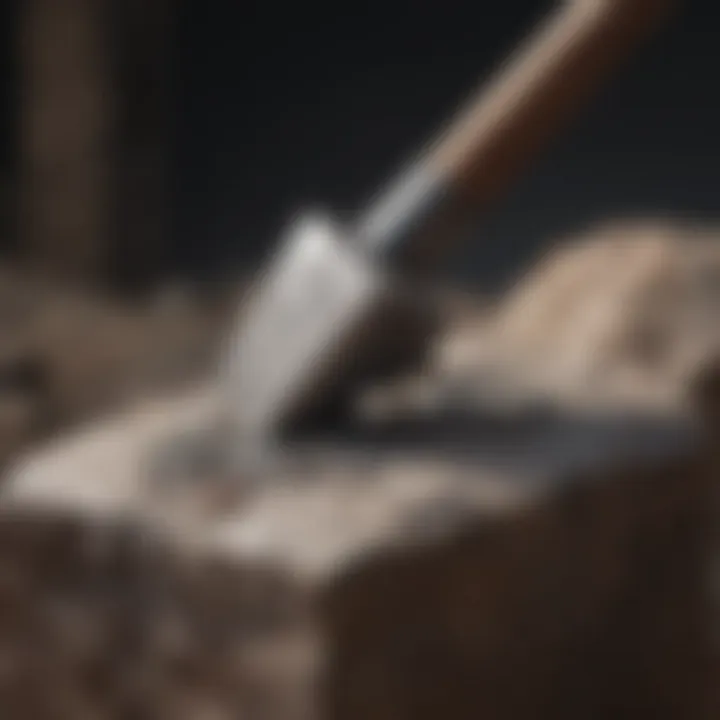
Pointed hammers are often the first choice for rockhounds delving into tougher materials. With a tapered end, they excel at splitting open rock layers and breaking through harder surfaces, providing access to hidden geodes or fossilized treasures. This hammer allows for precision, allowing the collector to target specific areas without too much swing. They're especially effective in regions with rocky terrain where other tools may falter. Their relative weight makes them a sturdy companion without being excessively burdensome. When selecting a pointed hammer, consider factors such as weight and grip comfort; a well-balanced hammer can make the difference, especially during extended use.
Flat Hammers
Flat hammers play a versatile role in any rockhound's toolkit. Designed with a flat striking surface, they excel at breaking apart softer rocks and making clean breaks in various minerals. This hammer is great for creating flat surfaces on specimens, allowing for easier analysis in the field. When you need to extract something delicate, a flat hammer minimizes the risk of damaging your find. Furthermore, the flat side can also be used to drive chisels or rock splices, increasing its functionality. Many rockhounds prefer it for its all-around performance, making it a staple tool in their collection.
Chiseling Hammers
Chiseling hammers take the functionality to another level. Featuring a broad, flat striking side combined with a chisel-like edge, these hammers are best suited for detailed work involving careful stone shaping. If your passion is sculpting or extracting fossils with intricate details, this type of hammer is ideal. It's like the difference between a simple tool and an artist's precise instrument—the refinements enable a level of artistry in your collecting. When using a chiseling hammer, it's essential to combine thoughtful striking with a keen eye for detail, applying just the right amount of force to enhance your work rather than obliterating it.
Specialty Hammers
The market is rife with specialty hammers, each tailored to meet unique needs of specific geological tasks. For example, some hammers may have a built-in pick on one side, allowing users to break through tougher rocks without needing a separate tool. Other versions may feature rubber heads, which can be used for delicate slicing of soft sedimentary rocks or fossilized specimens without causing damage. Such specialty hammers play a pivotal role in ensuring that collectors have just the right tool for any unforeseen discovery. As every rockhound is different, so too are the tools we choose; understanding these specialized implements encourages thoughtful collecting.
"Choosing the right rockhound hammer can be as critical as knowing what you're looking for. The tool should fit the task and your personal collecting style."
By knowing the various types of rockhound hammers, you can elevate your collecting and exploring experience. Each hammer adds a layer of depth to the process of studying and appreciating geological formations in their natural habitats.
Selecting the Right Hammer
Choosing the right rockhound hammer is pivotal for collectors aiming to get the most from their geological pursuits. A well-suited hammer not only enhances your efficiency but also minimizes the risk of damage to the specimens you seek. In this section, we will dive into two critical aspects to consider when selecting a hammer: understanding rock types and materials, as well as personal preferences, including grip.
Understanding Rock Types and Materials
When selecting a hammer, it's essential to take into account the specific types of rocks and materials you will be working with. The geology of a region dictates the hardness or softness of rocks, and using an inappropriate hammer can lead to fractured specimens or potential injury.
- Granite and Basalt: These igneous rocks are notoriously tough. A pointed hammer is preferred here, as it delivers concentrated force and can chip away at hard surfaces effectively.
- Sedimentary Rocks: If you are targeting softer rocks, such as sandstone or limestone, a flat hammer may do the trick. It allows for better coverage and ensures that the blows are spread evenly, helping to avoid breaking the specimens you wish to collect.
- Fossils: Fossils require a delicate touch. A chiseling hammer, along with chisel tools, might be better suited for the task, ensuring the fossils are extracted with precision and minimal damage.
Knowing the rock types means you can select a hammer tailored to their specific properties, improving both your collection's quality and your overall safety.
Personal Preferences and Grip
Your personal comfort when using a rockhound hammer can't be overstated. A good hammer feels more like an extension of your hand than a tool, allowing for greater ease of use and less fatigue during long outings. Here are some factors to consider:
- Weight: Depending on your physical condition and endurance, choose a hammer that offers a balance between heft and manageability. A heavier hammer can deliver more force, while a lighter one ensures that you can swing for longer without tiring.
- Handle Length and Material: The handle's length should allow you to swing comfortably without overreach. Materials can also have a big impact; for instance, fiberglass handles offer shock absorption, while wooden handles provide a more traditional feel.
- Grip: Whether you prefer a rubberized grip or a more natural wood finish affects your control and comfort. A comfortable grip can prevent slippage and ensure that the hammer strikes accurately at the intended point.
"Selecting the right rockhound hammer is akin to choosing the right paintbrush for an artist; it's all about the delicate balance between comfort and capability."
By giving these factors their due consideration, you enhance your exploring experience in areas rich in geological treasures. Remember, the right tool can mean the difference between a successful collecting trip and an outing where you come home empty-handed.
Proper Techniques for Collecting Rocks
Rockhounding is not just about swinging a hammer and hoping for the best; it’s an art form that requires finesse, knowledge, and a dash of respect for nature. With the right techniques, collectors can maximize their finds while ensuring that the environment remains unspoiled. This section discusses essential practices in rock collecting that can turn an ordinary outing into a fruitful adventure.
Safety First: Protective Gear and Precautions
Before diving headfirst into the collection process, it’s crucial to gear up properly. Safety shouldn’t take a back seat, as the risks associated with rock collecting, from falling debris to potential injuries caused by mis-hits, can be serious.
Protective gear includes:
- Safety goggles: To shield your eyes from splinters and flying rock chips.
- Gloves: Thick gloves protect your hands and provide a good grip on tools.
- Hard hats: In loose rock areas, wearing a hard hat can save you from unexpected falling rocks.
- Sturdy boots: Footwear with good ankle support and grip can help you navigate tricky terrain safely.
Be familiar with your surroundings. If you're in an area with loose rocks or steep inclines, take extra care to avoid slips and falls. Always keep a buddy system in mind, too—there's wisdom in not venturing out alone, especially in remote areas.
Effective Striking Techniques
When it comes to smashing rocks, technique is everything. Knowing how to wield your hammer properly can make the difference between a productive day and a series of missed opportunities. Here are some tips:
- Grip the hammer correctly: Hold the hammer close to its end for better force and control.
- Aim carefully: Position your hammer on the rock you intend to strike where you expect the breakage to occur. This involves observing natural fissures or softer sections.
- Controlled strikes: Use short and controlled strikes rather than wild swings. It maintains precision and minimizes the chance of injury.
- Angle your hits: Aiming for an angle can help in splitting rocks effectively rather than forcing a break. This tactic also decreases the risk of the hammer glancing off unexpectedly, potentially causing injury.
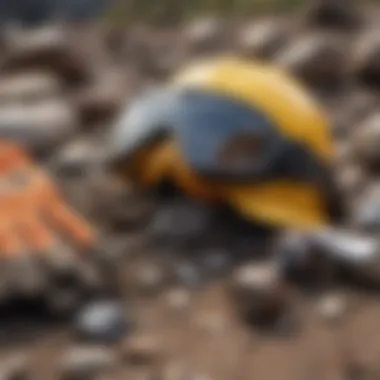
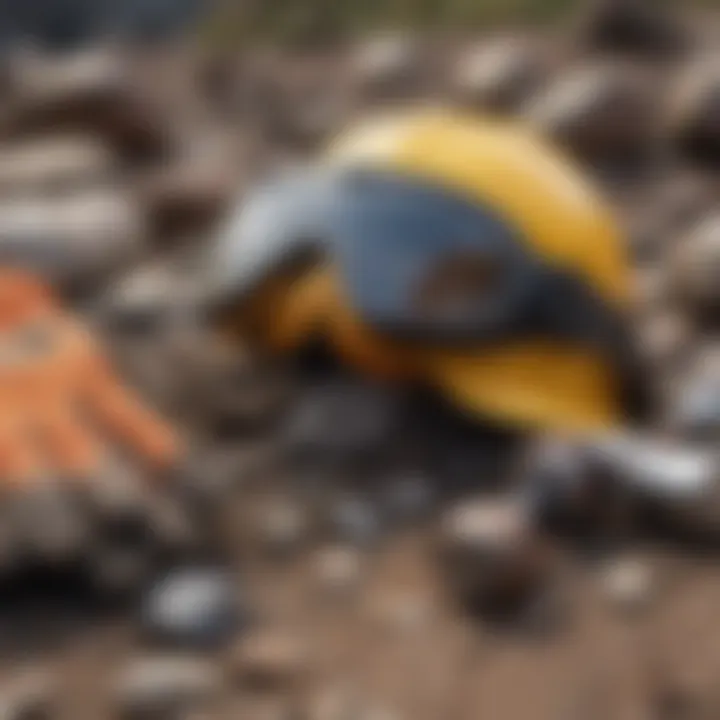
These techniques not only enhance your efficiency but also ensure that the tools last longer. A well-struck rock can yield better specimens than haphazard smashing.
Identifying Collection Sites
Finding the right location can sometimes feel like hunting for a needle in a haystack. However, there are tried-and-true methods to identify promising sites:
- Research local geology: Familiarize yourself with your area’s geological map. Websites like Wikipedia provide useful insights into mineral hotspots.
- Engage with local rockhound clubs: These communities often share valuable information about previous findings and good spots to explore. Joining reddit.com/r/rockhounds can provide a wealth of knowledge from seasoned enthusiasts.
- Visit road cuts: These areas often expose layers of rock and minerals that aren’t visible from the surface. Just ensure you abide by local regulations and don’t trespass on private land.
- Look for construction sites: Sometimes, digging projects can reveal interesting geological features worth exploring, but always check for permissions.
"Like a skilled treasure hunter, knowing where to look is often half the battle in rock collecting."
The more informed you are about geology and potential sites, the more successful your collecting excursions are likely to be. Understanding and implementing these techniques not only enhances your collection but also fosters a deep respect for the landscape you’re exploring.
Caring for Your Rockhound Hammer
Caring for your rockhound hammer is of utmost significance if you wish to ensure its longevity and efficiency. Just like a chef would never let a valuable knife go dull, collectors must maintain their tools. Neglect can lead to worn-out hammers that break easily or cause accidents in the field. Proper care not only extends the lifespan of the tool but also hones the collector's skills, allowing them to work effectively and safely in diverse geological settings.
Routine Maintenance Practices
Keeping your rockhound hammer in top condition involves a few straightforward maintenance practices. First off, cleaning the hammer after every use can do wonders. Dirt and debris might accumulate, leading to wear on the hammer’s head. Use a soft cloth or a wire brush to remove any material stuck to the head or handle.
- Inspect regularly: After each outing, take a moment to look for any chips or cracks in the hammer's head.
- Sharpen as needed: Depending on your usage, the striking surfaces may need sharpening. A well-sharpened hammer bites into the rock more effectively, reducing excessive force.
- Lubricate: Occasionally, you might want to apply a bit of oil to the handle, especially if it’s made of wood. This can prevent drying and cracking over time.
- Test the grip: Ensure that the grip is intact, as a loose grip can lead to reduced control, which poses a risk while striking rocks.
Storing Your Tools Safely
Once you finish using your hammer, where you store it can significantly affect its performance. An appropriate storage method keeps it safe from accidents and damage.
- Dry and clean: Before storing, ensure that the hammer is clean and dry to prevent rusting.
- Use a dedicated space: If possible, create a specific spot for your rockhound hammer in your garage or toolkit. Using a protective sleeve or wrapping it in a cloth can prevent it from knocking against other tools.
- Avoid damp areas: Moist environments can lead to rust and deterioration, especially in the metal parts of the hammer. Choose a cool, dry location.
"Taking care of your tools is taking care of your passion. A well-maintained hammer tells the tale of every rock you’ve struck, every fossil you've uncovered."
By following these simple yet essential practices, you can ensure that your rockhound hammer remains reliable for your adventures into the field. After all, in geology, every detail matters, and a well-cared-for tool can make all the difference in the treasures you uncover.
Integrating Hammers into Geological Education
Understanding how to incorporate rockhound hammers into geological education is more than just showing students the tool. It's about connecting the physical act of collecting rocks with the broader narratives of earth science. Physics, history, chemistry — all these fields dance together when a student swings a hammer, making it a powerful educational instrument.
Tools in the Classroom: Enhancing Learning
Rockhound hammers in the classroom do not just serve as tools; they become gateways. They enable learners to grasp complex concepts in geology in a more tactile way. Here’s how they can expand the educational experience:
- Experiential Learning: When students hold a hammer, they engage all their senses. It’s one thing to read about rock strata; it’s another to break open a rock and actually see the layers. Such hands-on experiences create lasting impressions.
- Critical Thinking: As students decide which hammer to use and how to apply technique, they exercise problem-solving skills. Questions that come up such as, "What type of hammer is best for this rock?" push them to understand material properties.
- Safety Awareness: Teaching how to handle tools responsibly instills a culture of safety. Students learn that respect for the tools means respect for their environment, reinforcing responsible collecting practices from the get-go.
"Hands-on experiences can awaken a deeper curiosity in students, leading them to explore beyond the classroom walls."
Field Trips: Practical Applications
Field trips can transform the mundane into the extraordinary, and the right tools make all the difference. Effectively integrating hammers into these excursions adds significant value to the learning process:
- Real-World Experience: Taking classroom knowledge outdoors provides a real-world context. When students collect samples, they not only find rocks but also gain insights into geological formations and the processes behind them.
- Collaboration and Teamwork: Field collecting often involves partnering up. Students discuss strategies on using hammers to minimize damage to precious specimens while maximizing their findings. This teamwork enhances communication skills.
- Environmental Literacy: Students learn respect for nature. Understanding how to collect sustainably during trips reinforces the ethics of rockhound activities, which is crucial for preserving natural habitats for the future.
The integration of rockhound hammers in educational contexts transcends simple demonstrations; they become essential to fostering a genuine enthusiasm for geology. With the proper focus on safety and practical application, they can inspire the next generation of geologists.
Collecting Ethics and Best Practices
When it comes to rock collecting, understanding the ethics of collecting is just as crucial as knowing how to swing a hammer. It's not only about obtaining beautiful specimens but also about being responsible stewards of our natural resources. The practices and ethics surrounding rock collection influence both the sustainability of the hobby and the preservation of the sites we explore.
Sustainable Collecting Methods
Sustainable collecting is the backbone of ethical practices in rock and fossil collecting. It emphasizes the importance of taking only what is needed and ensuring the continued health of geological sites. Collecting sustainably means:
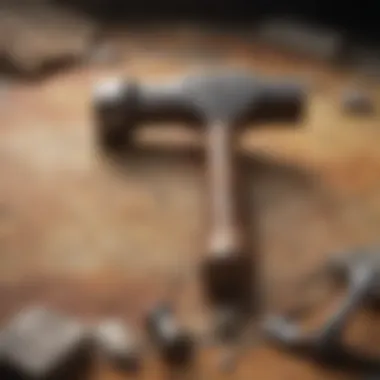
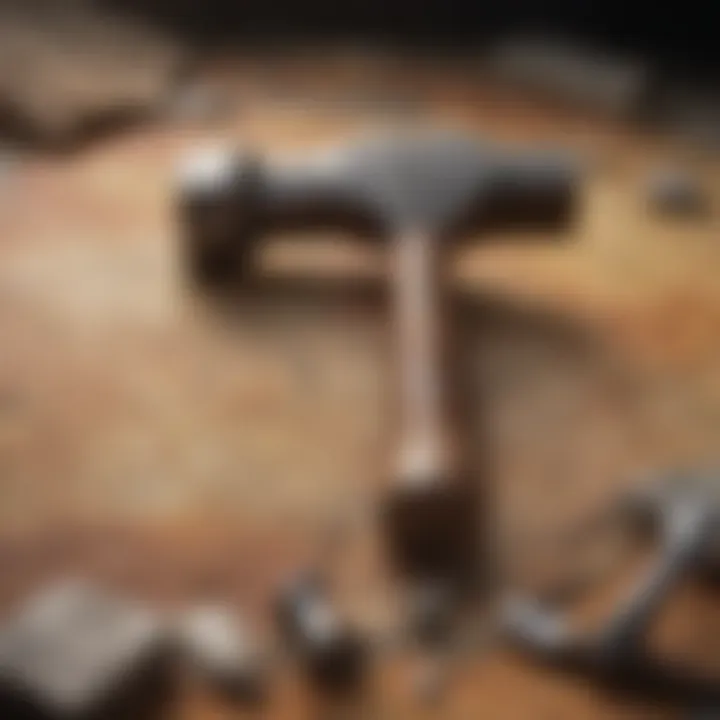
- Knowledge of Local Laws: Familiarize yourself with local regulations regarding collecting. Some areas, especially protected sites, may have strict rules or bans on collecting.
- Taking Only a Few Specimens: When venturing into a site, consider taking only small quantities. This minimizes your impact on the ecosystem and allows others the opportunity to enjoy the same experience.
- Avoiding Fragile Sites: Some locations are more delicate than they appear. Be mindful of potential erosion or habitat disturbance, and choose more resilient areas for collecting.
- Using Tools Wisely: When using hammers or chisels, strive for precision. This cuts down on unnecessary damage to the surrounding area.
Implementing these practices not only helps in conserving resources but also ensures that future generations can experience the joy of collecting. The thrill of discovery should never come at the cost of our environment.
Respecting Natural Sites
Maintaining a profound respect for natural sites is essential not only for ethical collecting but also for the overall integrity of the geological community. There are several ways to uphold this respect:
- Leave No Trace: Always clean up after your visits. This could mean packing out any trash or ensuring that tools and equipment don’t disturb the natural landscape.
- Engage with Local Communities: Before striking out on a collection journey, connect with local Indigenous communities or landowners. They can provide valuable insights and often have deep cultural ties to the land.
- Observation over Harvesting: There’s immense beauty in observing geological formations and fossil beds. Sometimes, just taking in the landscape is more rewarding than taking specimens. Consider sketching or photographing instead.
- Join Conservation Efforts: Many rockhound clubs and organizations participate in conservation initiatives. Being involved not only enhances your knowledge but also helps preserve the integrity of rockhounding for everyone.
Respecting the land you collect from is not merely an ethical obligation; it is a gesture of appreciation toward nature and its timeless processes.
Adhering to these practices enhances the experience of collecting and reinforces the relationship between enthusiasts and the earth. Each rock should symbolize not just the past it represents, but also our responsibility to protect the future.
Community and Collaboration in Collecting
The realm of rock and fossil collecting is not merely an individual endeavor; rather, it thrives on the synergy of community and collaboration. As one dives deeper into the intricate world of geology, the benefits of shared knowledge and experiences come to light. Engaging with others who share the same passion enhances skills, encourages sustainable practices, and fosters a sense of belonging among collectors.
Joining Rockhound Clubs
Rockhound clubs serve as essential hubs for enthusiasts, offering a wealth of resources and networks for anyone keen on mineral or fossil collecting. These clubs often host regular events, gatherings, and field trips, allowing members to explore sites collaboratively and share insights on their finds.
In these settings, new collectors can learn from seasoned ones. The exchange of tips, tricks, and techniques often occurs naturally, paving the way for growth and confidence in one’s collecting practices. Moreover, clubs may provide access to exclusive locations where members can dig and collect, thus enhancing the variety and quality of specimens one could acquire.
Some well-known rockhound clubs include:
- The Rockhounding Club of America
- The Geological Society of America
- The American Federation of Mineralogical Societies
Joining any of these clubs can significantly broaden one's horizons, both in terms of education and access to valuable resources.
Sharing Knowledge with Peers
Knowledge sharing is a crucial component of any successful community, particularly in the field of geology. When collectors share information about identification techniques, collection methods, or even ethical considerations, it strengthens the collective understanding of the hobby.
Active participation in knowledge-sharing can take many forms:
- Workshops and Seminars: Organized events where members can gather to learn from experts in specific areas, like fossil preparation or mineral identification.
- Online Forums and Social Media: Listening and contributing to discussions on platforms such as Reddit or dedicated Facebook groups can widen the circle of collaborative learning.
As individuals share their successes and failures, they help create a more informed and respectful collecting community. It’s a two-way street: when one person shares their unique experience, others benefit from that insight, enriching their own practices.
"The biggest treasure in rockhounding is not the rocks we collect, but the friendships we forge along the way."
The End: The Importance of Rockhound Hammers
Rockhound hammers serve not just as tools but as essential partners in the pursuit of geological treasures. This article has demonstrated how these instruments are more than simple devices for breaking rock. They form a nexus between curiosity, education, and sustainable practices in rock and fossil collecting. The meticulous selection of the appropriate hammer influences the entire collection process, where every strike holds potential for discovery.
Reflecting on Tools in Geological Pursuits
In any geological expedition, the tools you carry tell a story—not just about the rocks you hope to collect, but about your approach as a collector. A rockhound hammer is an extension of the geologist's intent and passion. Choosing the right hammer can delineate between frustration and success when searching for fossils or rare mineral specimens.
Each type of hammer offers unique advantages; the pointed hammer excels at penetrating hard surfaces while flat hammers are great for getting clean fractures in rock layers. Understanding these nuances can elevate the collecting experience, but it doesn't end there.
Rockhound hammers also symbolize a commitment to the craft. They embody the meticulous spirit of geologists who aim to not just collect, but to learn. A hammer over time develops a history with its owner; every nick and scratch is a reminder of past adventures, lessons learned, and geological mysteries deciphered.
Encouraging Continuous Exploration
To truly appreciate the wonders of geology, one must embrace a mindset of continuous exploration. Rockhound hammers not only facilitate this but encourage it through the adventure of discovery. Each outing with a hammer invites new experiences—whether it's thriving in the thrill of a successful find or the quiet moments reflecting on nature's beauty.
This journey fuels not just individual learning, but fosters community among fellow enthusiasts. Rockhound clubs, forums, and social media platforms like Facebook and Reddit facilitate knowledge sharing. When collectors exchange not just their findings but insights on tool utilization and maintenance, the entire community benefits.
In a world where scientific curiosity sometimes takes a backseat, rockhound hammers remind us of the importance of inquiry. The simple act of collecting can transform into an educational experience—one which extends beyond merely acquiring specimens.
"Every rock tells a story; with the right hammer, you just might uncover its secrets."
Thus, the journey continues beyond just the collector's bags filled with rocks; it extends into deeper understanding, respect for the environment, and shared knowledge. Each exploration comes with new lessons, urging us to keep our eyes—and minds—open.



